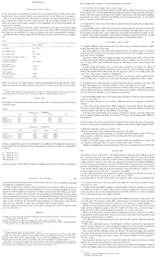>>64140662
>Energy isnt directly related to armor penetration
Correct but having alot of energy will allow inefficent designs (soft lead, large round ball) outperform more efficent designs (steel arrow head with hard stubby tip) by energy alone.
In the test study "For show or safety" they ballistically tested two breastplates that were claimed to be 17th century, BP-1 which had a weight of 5.48 kilo and BP-2 weight of 2.42 kilo
BP-1 had a thickness from 7.5mm in the middle to 6-5mm and then 2-3mm at the edges would have been able to stop all the muskets in >>64140414 from 30meters.
BP-2 was determined to be a 18th century replica. It had an average thickness of only 1.75mm with very small deviation of 0.3mm in thicknees. It was infact thinner in the middle while thicker at the edge which ment it was made from a single even plate that was later bent, stretched and formed into a breastplate. It would only be able to stop two of the muskets at 100 meters that BP-1 would stop at 30.
The SN-42 is either 2mm or 2.6mm thick steel, The 6B1 is 6.4mm -5.3mm -4.1mm thick aluminum plates. Both are made from more modern material then 17th century steel plate, they also probably have less impurites yet they are much thinner. They would probably stop all 1700 rifle muskets from 100 meters but would die at 30 meters and closer.
Civil war era musket are all rifled and most fire the minie ball. I dunno how much better a springfield 1861 firing a minie ball in terms of velocity and engery is compared to a 1700 flintlock musket, but I think it would higher.
>The effect would likely be similar to being hit by a lead shotgun slug, which is survivable with level II armor
I would rather have lvl3a just for the extra layers of kevlar. Depending on what model of kevlar vest you should be able to stop rifle muskets firing minie balls if is equal to a interceptor vest kevlar panel.
https://www.youtube.com/watch?v=4qSVOZfp3R4
https://www.youtube.com/watch?v=8xi35DqbchA
